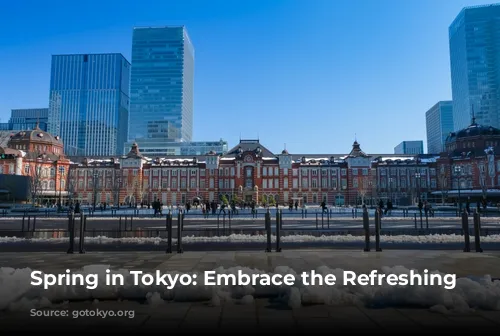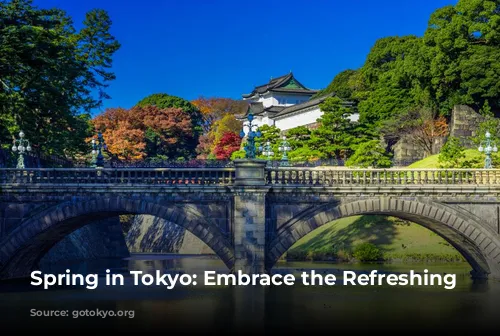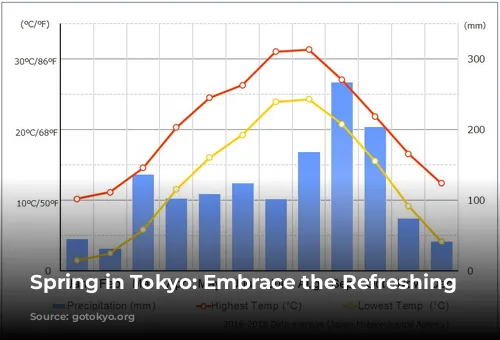Spring in Tokyo is a delightful time to explore the city. While early spring still carries a hint of winter’s chill, don’t worry, by May, the city bursts into life with lush greenery and comfortably warm days. You can shed your heavy coats and embrace the sunshine in short sleeves! Although the mornings and evenings might still be a bit nippy, the daytime weather is perfect for outdoor adventures, making it an ideal time to soak in the city’s beauty. Remember to layer your clothes for those quick temperature changes—you can be cool and comfortable in the warmth of the day but stay cozy and warm if a breeze blows through!

Rainy Season: Embrace the Charm of Drizzle
From June to mid-July, Tokyo experiences its rainy season—a period of gentle drizzle that adds a unique charm to the city. While a light rain jacket might come in handy, you can skip the heavy ones. The humidity can make them feel oppressive. If you plan to explore Tokyo on foot or even venture into the Okutama area for hiking or camping, consider waterproof shoes to keep your feet dry. And of course, an umbrella is essential. Don’t worry, affordable umbrellas are readily available at convenience stores.

Summer in Tokyo: Embrace the Heat
Once the rainy season passes, intense summer heat takes over Tokyo. Temperatures can soar above 35 degrees! Stay hydrated and well-rested to combat the heat. Even after sunset, the temperature seldom drops below 25 degrees, creating long, warm summer nights. Many locals use hand fans or parasols to beat the heat—effective methods!
When it comes to summer clothing, light and comfortable attire is essential. Tokyo is a city where all styles of fashion thrive, but blending in with the locals means avoiding anything too casual or revealing. Loose-fitting sleeveless shirts, yoga pants, baggy shorts, and flip-flops might make you stand out.

Autumn in Tokyo: Embrace the Vibrant Colors
As September arrives, the scorching heat begins to ease, but temperatures above 30 degrees can still linger. This period is also known for typhoons, which can disrupt travel and outdoor events. However, the temperature and humidity gradually drop as autumn approaches. Around late October, leaves begin to turn from green to vibrant red, yellow, and orange—a beautiful sight, especially in the Okutama area, then spreading throughout the rest of the city. Check out Tokyo Amesh for real-time weather updates to plan your activities accordingly. Layering is key for early autumn.

Winter in Tokyo: Embrace the Winter Wonderland
Throughout most of December, autumnal weather persists, with real cold setting in only in January. Temperatures rarely drop below 0 degrees, typically ranging between one and ten degrees. Days are shorter, with twilight arriving around 4:30 p.m., and snow is a possibility. If you’re visiting in January or February, pack sweaters, a coat, gloves, scarves, and a winter hat. Heavier winter wear might be unnecessary unless you’re planning to spend time outdoors in the more rural Okutama area. If you’re seeking a warm winter getaway, consider the Ogasawara Islands, a part of Tokyo that enjoys temperatures above 15 degrees even in the coldest months.
Temperature and Precipitation in Tokyo’s Surrounding Areas
The Tama area, located west of central Tokyo, experiences slightly cooler temperatures than the city center. The highest average temperature in August, Japan’s warmest month, is 32°C. The coldest month, January, has average highs of 10°C. Rainfall is similar to other areas of Tokyo, with precipitation occurring even during the driest month.
The Izu Islands, located south of mainland Tokyo, have warmer climates as you move further south. Izu Oshima, the closest island to Tokyo, has average high temperatures of 30°C in August and 12°C in January. Hachijojima, located further south, has average highs of 31°C in August and 13°C in January. Rain is common throughout the year, with June, September, and October being the wettest months.
The Ogasawara Islands, even further south, enjoy a consistently warm climate, with average high temperatures of 30°C in August and 22°C in February. However, strong winds between January and March can make a jacket advisable during those months. Precipitation is less frequent than on the mainland, though rainy days occur in every month. These islands are also sometimes affected by typhoons.

